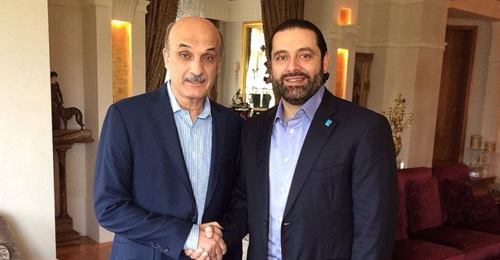A potential breakup Between Future Movement and Lebanese Forces
Myra Abdallah/Now Lebanon/December 16/15
Will disagreement between Future Movement and Lebanese Forces caused by Hariri’s nominating Frangieh for president lead to a schism between the two allies?
Today, the 33rd parliamentary session set to elect a new president was postponed until 7 January, due to lack of quorum. Suleiman Frangieh, suggested after Future Movement head Saad Hariri’s initiative, was not elected as the new Lebanese president. But the controversy Frangieh’s candidature has created in the Lebanese political scene has not gotten any better, especially between the Future Movement and the Lebanese Forces.
The divergence between the parties is more obvious today than ever. After the parliament session, Ahmad Fatfat, Future Movement MP, said that Lebanese Forces leader Samir Geagea is still his party’s candidate as long as no consensual candidate is suggested. In return, Lebanese Forces MP Georges Adwan said Hariri’s initiative will not cause a clash between the two parties. Thus, the two parties are trying to maintain a common ground in order to spare Lebanon a dead-end political crisis. But their profound disagreement can’t be hidden anymore.
“It is obvious that the relationship is really bad,” said analyst Hazem Saghieh. “It’s bad because of the fragile composition of the March 14 coalition and its inability to overtake the prevailing sectarian compositions. In addition, Hariri’s behavior was very hasty, unpredictable and inconsiderate. It seems that he prioritized his personal over his relationship with his allies.”It’s not the first time the two parties have disagreed. However, over the past 10 years they have always managed to reach better endings, resolve their issues and maintain their alliance — none of which are very obvious at present. “This time it is different,” says Saghieh. “It is obvious that this disagreement is a quantum leap regarding the post-Syrian crisis period. Currently, any Lebanese politician’s shift is directly related to the regional transformation. This is what’s causing the current disparity more serious.”
On the other hand, in line with Adwan and Fatfat’s statements, members from both parties NOW spoke to said that the relationship between the two parties will not suffer a complete rupture. Fatfat told NOW that both parties are holding tight to their strategic alliance and their continuous communication with all March 14 components. “Although the relationship was tense even before Hariri’s initiative because of several divergences, the constant communication between Future Movement and Lebanese Forces contributed in easing the tensions. We agreed that the alliance will never be affected even if we have different points of view,” he said. “In addition, as I said today, Samir Geagea is still our candidate even if, meanwhile, Hariri is trying to find a way out of the presidential deadlock by suggesting the name of another person, since it became obvious that Geagea’s candidature can’t lead anywhere.”
The popular bases of both parties are not on good terms lately, either. Last week, as a result of several clashes between Lebanese Forces and Future Movement supporters on social media, the administrations of both parties had to issue official statements asking their supporters not to attack the other party. “The popular base of March 14 knows how to hold their political leaders accountable at the right moment. The tension between the popular base and Hariri’s initiative, which I consider a healthy anger, happened because the initiative was seen as a coup against the principles according to which March 14 was created,” said a Lebanese Forces spokesperson who spoke on condition of anonymity. “However, regardless of all the tension we can see, the relationship between Lebanese Forces and Future Movement is excellent, very steady, and can never be extinguished.” He also said that the Lebanese Forces did not completely reject Frangieh’s nomination and is still in the process of negotiating his candidature with its allies.
The current position of both parties seems to be an attempt to restore a broken relationship and to save what is left of the March 14 coalition, especially given that a large number of Sunnis have recently tried to join the Lebanese Forces. A number of them were announced as members at a ceremony organized by the Christian party in Akkar last week. Saghieh says that the parties are trying to “tinker with the broken image,” as they do every time they disagree and that this is not a concern for March 14 alone. He also says that what is happening today in Lebanon and region is a “reshuffling of the political map,” and that “the dualism of March 8 and March 14 no longer exists.” Instead, he says, “new equations might be set; an alliance between [Nabih] Berri, [Walid] Jumblatt, Hariri and Frangieh might be created.”“Some people are seeing Frangieh’s nomination as a positive step since it indicates the loss of Bashar Assad in Syria,” he said. “If the loss results in getting Frangieh as a president in Lebanon, I wonder what his victory would have got us.”
Israel’s ongoing espionage in Lebanon
Nicholas Blanford/Now Lebanon/December 16/15
Is it really possible that Israeli Special Forces personnel have been roaming South Lebanon undetected?
The recent discovery of several Israeli espionage devices in South Lebanon demonstrates that despite the focus on the conflict in neighboring Syria, there has been no let up in the covert intelligence war between Hezbollah and Israel. The latest device unearthed in South Lebanon was found over the weekend near Touline in the central sector of the southern border district. It is not entirely clear what was found — the Lebanese Army did not issue a statement on the discovery and the only news came from the National News Agency, which said army engineers dismantled an “Israeli espionage device.”
On 1 December, a booby-trapped tapping device was blown up south of Marjayoun on the Bourj Mallouk-Khiam road, wounding two workmen who were installing water pipes nearby. Photographs of the scene showed a pit at least a meter deep where the device was buried, several large boxes and cables, all of which suggested an Israeli wire tapping operation in progress. The location was in view of the Israeli military outpost in Metula, three kilometers to the south, and it is likely that the Israelis chose to destroy the device by remote control before it was discovered by the approaching workmen.
Israeli troops briefly occupied the flat plain between Marjayoun and Khiam during the 2006 War, which could have afforded them cover to set up the tap if, indeed, that is when it was installed. But in recent years there have been other examples of Israeli taps on Hezbollah communications lines in areas where Israeli troops were not operating in 2006, nor even during the years of occupation before 2000 (which was before Hezbollah began installing its fiber-optic communications system). Other than last weekend’s discovery of a device in Touline, previous tapping operations include one in Zrarieh, just north of the Litani River, near Nabatieh, which was found in July 2012. It, too, included several bulky boxes and at least 80 meters of additional connecting cable. In September 2014, Hussein Haidar, a Hezbollah engineer, was killed near Adloun when he attempted to dismantle another espionage device.
Reports at the time variously claimed it was either a surveillance device with long-range cameras and radio transmitters, similar to those discovered by the army in 2010 on the Sannine and Barouk mountains, or another fiber-optic tap.
In December 2011, an Israeli pilotless reconnaissance drone blew up a booby-trapped tapping device in a valley between Srifa and Deir Kifa in the south as a team of Hezbollah engineers, apparently having detected the interception, drew close.
There are various ways to tap into a fiber-optic cable. While it is not entirely clear which method the Israelis are using, the simplest is to clamp the cable to create micro bends that allow some of the data-conveying photons to bleed out. The amount of light diverted from the cable is minuscule but sufficient to allow the data to be interpreted.
There are also means of detecting intrusions on fiber-optic cables, including incorporating a sensor that sounds the alarm if anyone tampers with the fibers. Another method is the use of optical power monitors that detect minute fluctuations in the power level, suggesting a potential leak via a tap. An optical time-domain reflectometer is an instrument that is used to check the integrity of a length of fiber-optic cable to ensure that it is working properly. It can be used not only to detect potential taps, but also mark the location along the length of the cable. It is unclear exactly what method Hezbollah uses to detect intrusions on its communications network, but it is evident from past incidents that it has the capability to trace Israeli interceptions.
The first known discovery by Hezbollah of an Israeli tap on its lines was in October 2009 in a valley near Houla, in South Lebanon, about a kilometer from the border. A Hezbollah team walked along the valley floor and dug a hole every few meters, presumably to test the data flow on the cable, before moving on. An Israeli drone flew overhead, closely monitoring the Hezbollah team. Eventually, the team discovered the tapping device, booby-trapped with explosives, buried underground and connected to a transmitter about 10 meters away and a battery pack containing 360 individual batteries. The Hezbollah team backed away and the drone detonated the device by remote control, but only the transmitter was destroyed due to faulty explosives. UNIFIL and the Lebanese Army, alerted by the blast, arrived at the scene and took pictures and studied the remaining devices. The Israelis contacted UNIFIL and warned the peacekeepers to stay away as they were still trying to destroy the evidence, which they succeeded in doing the following day.
This hidden intelligence war between Hezbollah and Israel rages on silently and only on rare occasions do examples break the surface into the public domain.
Despite Hezbollah’s technical prowess in detecting taps, the fact that the Israelis are able to conduct the interceptions in the first place exposes a flaw in the party’s operational security. The Zrarieh tap in 2012, for example, was located only a few meters from a main road on the edge of the village. The tapping devices, along with radio transmitter and battery pack, are heavy and bulky. The degree of technical capability required in finding the cable to tap, lugging heavy equipment to the location, hooking it up to the fiber and digging holes large enough to contain and hide the tapping device, transmitter and power supply, and then escape the scene unnoticed, suggests the work of highly-trained personnel rather than local Lebanese collaborators. Is it really possible that Israeli Special Forces personnel have been roaming South Lebanon undetected, planting taps on Hezbollah’s communications cables?
***Nicholas Blanford is Beirut correspondent of The Christian Science Monitor and author of Warriors of God: Inside Hezbollah’s Thirty-Year Struggle Against Israel.




















